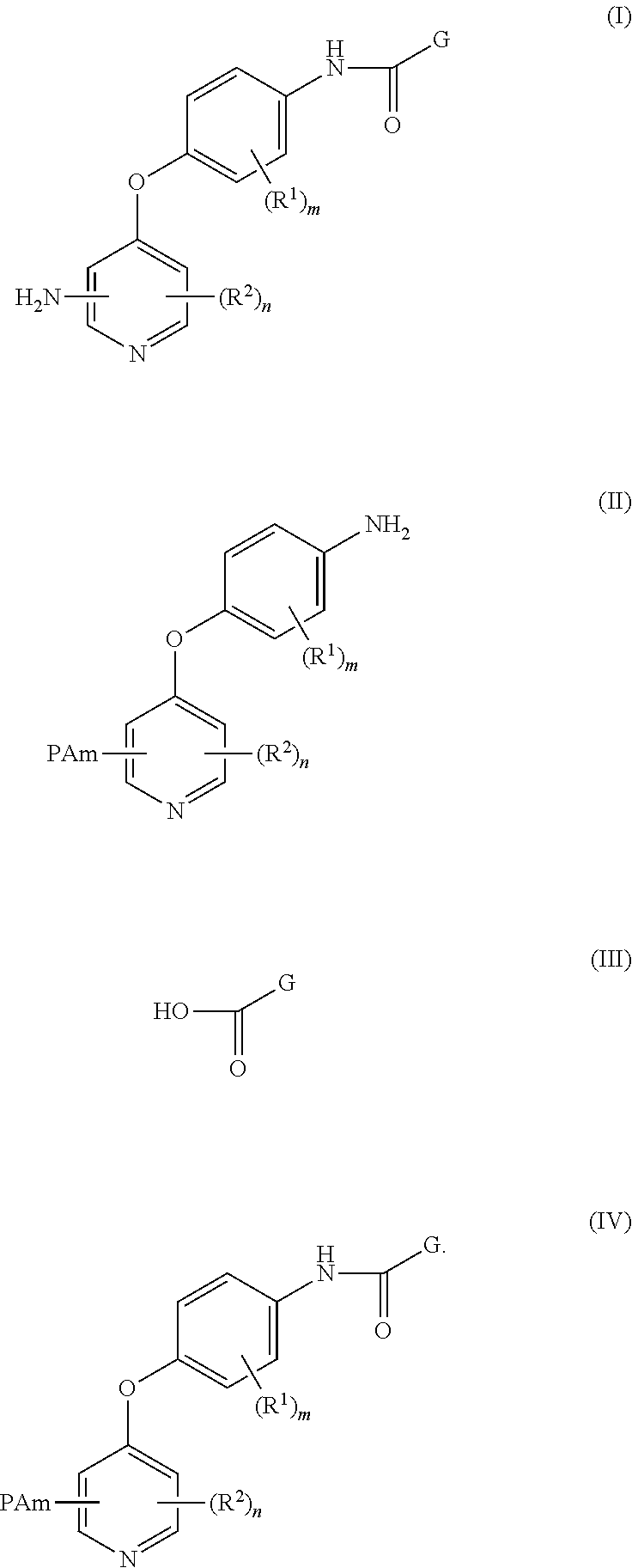4-pyridinone compounds and their use for cancer
a technology of pyridinone compounds and cancer, which is applied in the field of preparing pyridinone compounds, can solve the problems that the rearrangement step of hofmann is not readily adaptable to commercial scale synthesis
- Summary
- Abstract
- Description
- Claims
- Application Information
AI Technical Summary
Benefits of technology
Problems solved by technology
Method used
Image
Examples
example 1
Preparation of N-(4-(2-amino-3-chloropyridin-4-yloxy)-3-fluorophenyl)-4-ethoxy-1-(4-fluorophenyl)-2-oxo-1,2-dihydropyridine-3-carboxamide
[0127]
Step 1. Preparation of 3-Chloro-2-(diphenylmethyleneamino)pyridin-4(1H)-one
[0128]
[0129]To a reactor, 35 L of MeTHF and 5.0 kg of 2,3 dichloropyridine were charged and agitation started. Next, 0.155 kg of palladium acetate, 0.64 kg of rac-BINAP and 23.0 kg of cesium carbonate were added to the above reaction mixture, followed by the addition of 6.2 kg of benzophenone imine, while maintaining the temperature between 25 and 28° C. The reaction mixture was heated to 80-85° C. and stirred for 24 hours. After the reaction was complete, the reaction mixture was cooled to 25-30° C. The precipitate was filtered off and the solids were washed twice with 20 L of THF. The filtrate was charged back to the equipment and concentrated to minimum volume.
[0130]In a separate reactor, 35 L of THF and 10 L of diisopropylamine were charged under nitrogen atmospher...
example 3
[0187]To a solution of N-(4-(3-chloro-2-(diphenylmethyleneamino)pyridin-4-yloxy)-3-fluorophenyl)-5-(4-fluorophenyl)-4-oxo-1,4-dihydropyridine-3-carboxamide (410 mg, 0.65 mmol) in THF (10 mL) at room temperature was added aqueous HCl (2 M, 0.81 mL, 1.62 mmol). The reaction mixture was stirred at room temperature for 1 h and then concentrated in vacuo. Cold 5% aq. NaHCO3 (5 mL) was then added to the residue. The solid that formed was collected by filtration, washed with water and then ether, and dried under vacuum to give the desired product (275 mg, 90%). 1H NMR (DMSO-d6) δ 13.31 (s, 1H), 12.70 (br s, 1H), 8.63 (d, 1H, J=1.30 Hz), 8.09 (d, 1H, J=1.50 Hz), 8.02 (dd, 1H, J=2.50, 13.10 Hz), 7.76 (d, 1H, J=5.50 Hz), 7.71 (m, 2H), 7.44 (dd, 1H, J=1.50, 8.80 Hz), 7.31 (t, 1H, J=8.80 Hz), 7.27 (t, 2H, J=8.80 Hz), 6.43 (br s, 2H), 5.96 (d, 1H, J=5.60 Hz); MS (ESI+) m / z 469 (M+H)+.
N-(4-(2-Amino-3-chloropyridin-4-yloxy)-3-fluorophenyl)-5-(4-fluorophenyl)-4-oxo-1,4-dihydropyridine-3-carboxamide...
example 4
Alternative Synthesis of 3-Chloro-N-(diphenylmethylene)-4-(2-fluoro-4-nitrophenoxy)pyridin-2-amine
Preparation 4A: 2,3-dichloropyridin-4-ol
[0189]
[0190]A first solution was prepared by dissolving 2,3-Dichloropyridine (100 g, 0.68 mol) and triisopropyl borate (315 mL, 1.37 mol) in THF (150 mL). The resulting solution was cooled to −10° C. In a separate reactor, a second solution was prepared by dissolving diisopropylamine (150 mL, 1.07 mol) in THF (500 mL). The second solution was cooled to −10° C. and under nitrogen, n-butyl lithium (420 mL, 1.05 mol) was added over 20 min. After stirring for 10 min, the second solution was added slowly to the first solution via vacuum transfer.
[0191]The reaction mixture was stirred for 3 hrs at 22° C. until HPLC analysis indicated reaction completion. Water (1.00 L) was added to the mixture, followed by addition of sodium percarbonate (238 g) in two portions. The resulting mixture was allowed to stir at 20° C. for 1 h. The pH of the mixture was adjus...
PUM
| Property | Measurement | Unit |
|---|---|---|
| temperatures | aaaaa | aaaaa |
| temperatures | aaaaa | aaaaa |
| temperatures | aaaaa | aaaaa |
Abstract
Description
Claims
Application Information
 Login to View More
Login to View More - R&D
- Intellectual Property
- Life Sciences
- Materials
- Tech Scout
- Unparalleled Data Quality
- Higher Quality Content
- 60% Fewer Hallucinations
Browse by: Latest US Patents, China's latest patents, Technical Efficacy Thesaurus, Application Domain, Technology Topic, Popular Technical Reports.
© 2025 PatSnap. All rights reserved.Legal|Privacy policy|Modern Slavery Act Transparency Statement|Sitemap|About US| Contact US: help@patsnap.com



